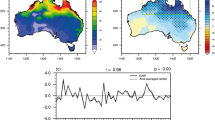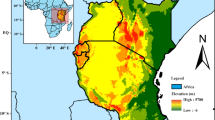Abstract
La Niña was forecasted to be one of the predominant climatic modes in the 2020 boreal autumn, taking into consideration its impact on the short rain (October to November rainfall) in eastern Africa. Parallel to La Niña and just 2 months before the start of the 2020 short rain, the Greater Horn of Africa Regional Outlook Forum published extremely strong projections of below-normal rainfall in Burundi, Rwanda, most parts of Uganda, Kenya’s southern region, and Tanzania. On the other hand, several regions of East Africa (EA) saw above average rainfall, especially in November. The current study examines the core and potential drivers causing the 2020 November rainfall to deviate from its historical response to the La Niña event. The driving force responsible for the wetter-than-anticipated 2020 November rainy conditions was identified. Although the ocean surface favors a negative phase of the Indian Ocean Dipole mode, it normally acts to suppress the short rain in EA, the mode decayed sooner than its life cycle in October. Lastly, the Madden–Julian Oscillation (MJO) in the Indian Ocean acted to reverse or weaken the Walker circulation (WC), the surface westerly (northeasterly) wind flow from the Congo Basin (central Indian Ocean) which conveys moist (warm) unstable air to EA, thereby promoting convective activity and rainfall. The study further identifies the reasons for dry conditions in October and December. In October, the MJO strength in the Maritime Continent and Western Pacific was associated with Somali low-level jet-like and WC across the Indian Ocean. The latter caused subsidence in EA, whereas the former triggered a strong friction-induced sinking motion along the eastern coast of Africa. To create a dry condition, they both collaborated. In December, La Niña strengthened WC across the Indian Ocean which induced subsidence in EA and resulted in poor rainfall. The diversity of mechanisms of MJO influence is relevant to problems of sub-seasonal weather forecasts for EA.










Similar content being viewed by others
Data availability
The datasets generated during and/or analyzed during the current study are available upon request on the corresponding author.
Code availability
The code analyzed during the current study is available from the corresponding author on reasonable request.
References
Abram NJ, Wright NM, Ellis B et al (2020) Coupling of Indo-Pacific climate variability over the last millennium. Nature 579:385–392. https://doi.org/10.1038/s41586-020-2084-4
Anandh PC, Vissa NK, Broderick C (2018) Role of MJO in modulating rainfall characteristics observed over India in all seasons utilizing TRMM. Int J Climatol 38:2352–2373. https://doi.org/10.1002/joc.5339
Arcodia MC, Kirtman BP, Siqueira LSP (2020) How MJO teleconnections and ENSO interference impacts U.S. precipitation. J Clim 33:4621–4640. https://doi.org/10.1175/JCLI-D-19-0448.1
Behera SK, Luo J-J, Masson S et al (2005) Paramount impact of the Indian Ocean Dipole on the East African short rains: a CGCM study. J Clim 18:4514–4530. https://doi.org/10.1175/JCLI3541.1
Berhane F, Zaitchik B (2014) Modulation of daily precipitation over East Africa by the Madden–Julian Oscillation*. J Clim 27:6016–6034. https://doi.org/10.1175/JCLI-D-13-00693.1
Black E, Slingo JM, Sperber KR (2003) An observational study of the relationship between excessively strong short rains in coastal East Africa and Indian Ocean SST. Mon Weather Rev 74–94. https://doi.org/10.1175/1520-0493(2003)131<0074:AOSOTR>2.0.CO;2
Blunden J, Boyer T (2021) State of the Climate in 2020. Bull Am Meteorol Soc 102:S1–S475. https://doi.org/10.1175/2021BAMSStateoftheClimate.1
Chang’a LB, Kijazi AL, Mafuru KB et al (2020) Understanding the evolution and socio-economic impacts of the extreme rainfall events in March-May 2017 to 2020 in East Africa. Atmos Clim Sci 10:553–572. https://doi.org/10.4236/acs.2020.104029
Deser C, Phillips AS, Alexander MA (2010) Twentieth century tropical sea surface temperature trends revisited. Geophys Res Lett 37:n/a-n/a. https://doi.org/10.1029/2010GL043321
Dezfuli AK, Nicholson SE (2013) The relationship of rainfall variability in Western Equatorial Africa to the tropical oceans and atmospheric circulation. Part II: The Boreal Autumn. J Clim 26:66–84. https://doi.org/10.1175/JCLI-D-11-00686.1
Findlater J (1970) A major low-level air current near the Indian Ocean during the northern summer. Interhemispheric transport of air in the lower troposphere over the western Indian Ocean. Q J R Meteorol Soc 96:551–554. https://doi.org/10.1002/qj.49709640919
Funk C, Peterson P, Landsfeld M et al (2015) The climate hazards infrared precipitation with stations—a new environmental record for monitoring extremes. Sci Data 2:150066. https://doi.org/10.1038/sdata.2015.66
Goddard L, Graham NE (1999) Importance of the Indian Ocean for simulating rainfall anomalies over eastern and southern Africa. J Geophys Res Atmos 104:19099–19116. https://doi.org/10.1029/1999JD900326
Hastenrath S (2000) Zonal circulations over the Equatorial Indian Ocean. J Clim 13:2746–2756. https://doi.org/10.1175/1520-0442(2000)013%3c2746:ZCOTEI%3e2.0.CO;2
Hastenrath S, Polzin D, Mutai C (2007) Diagnosing the 2005 drought in Equatorial East Africa. J Clim 20:4628–4637. https://doi.org/10.1175/JCLI4238.1
Hastenrath S, Polzin D, Mutai C (2011) Circulation mechanisms of Kenya rainfall anomalies. J Clim 24:404–412. https://doi.org/10.1175/2010JCLI3599.1
Hogan E, Shelly A, Xavier P (2015) The observed and modelled influence of the Madden-Julian Oscillation on East African rainfall. Meteorol Appl 22:459–469. https://doi.org/10.1002/met.1475
Huang B, Thorne PW, Banzon VF et al (2017) Extended reconstructed sea surface temperature, version 5 (ERSSTv5): upgrades, validations, and intercomparisons. J Clim 30:8179–8205. https://doi.org/10.1175/JCLI-D-16-0836.1
Kanamitsu M, Ebisuzaki W, Woollen J et al (2002) NCEP–DOE AMIP-II reanalysis (R-2). Bull Am Meteorol Soc 83:1631–1644. https://doi.org/10.1175/BAMS-83-11-1631
Kebacho LL (2021) Anomalous circulation patterns associated with 2011 heavy rainfall over northern Tanzania. Nat Hazards 109:2295–2312. https://doi.org/10.1007/s11069-021-04920-5
Kebacho LL (2022a) The role of tropical cyclones Idai and Kenneth in modulating rainfall performance of 2019 long rains over East Africa. Pure Appl Geophys 179:1387–1401. https://doi.org/10.1007/s00024-022-02993-2
Kebacho LL (2022b) Large-scale circulations associated with recent interannual variability of the short rains over East Africa. Meteorol Atmos Phys 134:10. https://doi.org/10.1007/s00703-021-00846-6
Kimani M, Hoedjes JCB, Su Z (2020) An assessment of MJO circulation influence on air–sea interactions for improved seasonal rainfall predictions over East Africa. J Clim 33:8367–8379. https://doi.org/10.1175/JCLI-D-19-0296.1
Li X, Hu Z, Tseng Y, et al (2022) A historical perspective of the La Niña event in 2020/2021. J Geophys Res Atmos 127. https://doi.org/10.1029/2021JD035546
Liebmann B, Smith CA (1996) Description of a complete (interpolated) outgoing longwave radiation dataset. Bull Amer Meteor Soc 77:1275–1277
Lim E-P, Hendon HH, Arblaster JM et al (2016) Interaction of the recent 50 year SST trend and La Niña 2010: amplification of the Southern Annular Mode and Australian springtime rainfall. Clim Dyn 47:2273–2291. https://doi.org/10.1007/s00382-015-2963-9
Lim E-P, Hudson D, Wheeler MC et al (2021) Why Australia was not wet during spring 2020 despite La Niña. Sci Rep 11:18423. https://doi.org/10.1038/s41598-021-97690-w
Lott FC, Christidis N, Stott PA (2013) Can the 2011 East African drought be attributed to human-induced climate change? Geophys Res Lett 40:1177–1181. https://doi.org/10.1002/grl.50235
MacLeod D, Caminade C (2019) The moderate impact of the 2015 El Niño over East Africa and its representation in seasonal reforecasts. J Clim 32:7989–8001. https://doi.org/10.1175/JCLI-D-19-0201.1
Moon J-Y, Wang B, Ha K-J (2011) ENSO regulation of MJO teleconnection. Clim Dyn 37:1133–1149. https://doi.org/10.1007/s00382-010-0902-3
Mutai C, Polzin D, Hastenrath S (2012) Diagnosing Kenya rainfall in boreal autumn: further exploration. J Clim 25:4323–4329. https://doi.org/10.1175/JCLI-D-11-00414.1
Nicholson SE (2015) Long-term variability of the East African ‘short rains’ and its links to large-scale factors. Int J Climatol 35:3979–3990. https://doi.org/10.1002/joc.4259
OCHA (2018) Office for the Coordination of Humanitarian Affairs (OCHA) flash update #6: Floods in Kenya 7 June 2018. https://reliefweb.int/report/kenya/ocha-flash-update-6-floods-kenya-7-june-2018. Accessed 21 November 2022
Saji NH, Goswami BN, Vinayachandran PN, Yamagata T (1999) A dipole mode in the tropical Indian Ocean. Nature 401:360–363. https://doi.org/10.1038/43854
Vashisht A, Zaitchik B (2022) Modulation of East African boreal fall rainfall: combined effects of the Madden–Julian Oscillation (MJO) and El Niño-Southern Oscillation (ENSO). J Clim 35:2019–2034. https://doi.org/10.1175/JCLI-D-21-0583.1
Wainwright CM, Finney DL, Kilavi M, et al (2020) Extreme rainfall in East Africa, October 2019–January 2020 and context under future climate change. Weather wea. 3824. https://doi.org/10.1002/wea.3824
Wang B, Rui H (1990) Synoptic climatology of transient tropical intraseasonal convection anomalies: 1975?1985. Meteorol Atmos Phys 44:43–61. https://doi.org/10.1007/BF01026810
Wheeler MC, Hendon HH (2004) An all-season real-time multivariate MJO index: development of an index for monitoring and prediction. Mon Weather Rev 132:1917–1932. https://doi.org/10.1175/1520-0493(2004)132%3c1917:AARMMI%3e2.0.CO;2
Acknowledgements
We sincerely acknowledge the efforts of the editor and the anonymous reviewers for their insightful comments in improving the flow and quality of our manuscript.
Author information
Authors and Affiliations
Contributions
L. L. K: conceptualization, methodology, data curation, formal analysis and investigation, visualization, writing—original draft preparation, writing—review and editing; I. S.: methodology, formal analysis, writing—review and editing.
Corresponding author
Ethics declarations
Competing interests
The authors declare no competing interests.
Ethics approval
Not applicable.
Consent to participate
Not applicable.
Consent for publication
Not applicable.
Conflict of interest
The authors declare no competing interests.
Additional information
Publisher's note
Springer Nature remains neutral with regard to jurisdictional claims in published maps and institutional affiliations.
Supplementary Information
Below is the link to the electronic supplementary material.
Rights and permissions
Springer Nature or its licensor (e.g. a society or other partner) holds exclusive rights to this article under a publishing agreement with the author(s) or other rightsholder(s); author self-archiving of the accepted manuscript version of this article is solely governed by the terms of such publishing agreement and applicable law.
About this article
Cite this article
Kebacho, L.L., Sarfo, I. Why Eastern Africa was not dry during the 2020 short rainy season despite La Niña and a negative Indian Ocean Dipole: Interplay between the Madden-Julian Oscillation and La Niña in modulating short rain. Theor Appl Climatol 153, 1191–1201 (2023). https://doi.org/10.1007/s00704-023-04519-9
Received:
Accepted:
Published:
Issue Date:
DOI: https://doi.org/10.1007/s00704-023-04519-9




